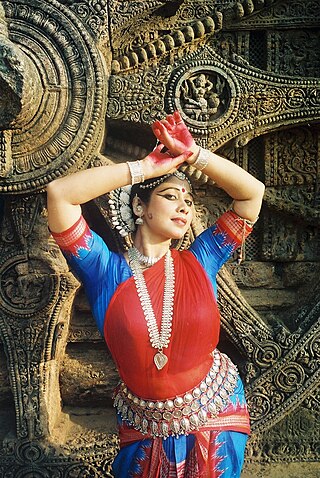
Chhattisgarh is a landlocked state in Central India. It is the ninth largest state by area, and with a population of roughly 30 million, the seventeenth most populous. It borders seven states – Uttar Pradesh to the north, Madhya Pradesh to the northwest, Maharashtra to the southwest, Jharkhand to the northeast, Odisha to the east, Andhra Pradesh and Telangana to the south. Formerly a part of Madhya Pradesh, it was granted statehood on 1 November 2000 with Raipur as the designated state capital.

According to Hindu scriptures, Vasudeva, also called Anakadundubhi, is the father of the Hindu deities Krishna, Balarama, and Subhadra. He was a king of the Vrishnis, and a Yadava prince. The son of the Yadava king Shurasena, he was also the second cousin of Nanda, the foster-father of Krishna. His sister Kunti was married to Pandu.

The Gondi (Gōṇḍī) or Gond people, who refer to themselves as "Koitur", are an ethnolinguistic group in India. Their native language, Gondi, belongs to the Dravidian family. They are spread over the states of Madhya Pradesh, Maharashtra, Chhattisgarh, Uttar Pradesh, Telangana, Andhra Pradesh, Bihar, and Odisha. They are listed as a Scheduled Tribe for the purpose of India's system of reservation.

Raipur district is a district in the Chhattisgarh state of India. Its administrative headquarters is the city of Raipur. The district is rich in mineral resources and there are many wildlife sanctuaries. With a population of 2 million, it is the most populous district of Chhattisgarh.

Chhattisgarh is a state of India with strong tribal traditions of music and dance. The state of Chhattisgarh is best known for its deep roots in folk music, which originated from its long history of tribal involvement.
Khairagarh is a city in Khairagarh-Chhuikhadan-Gandai district. Formerly, it was the part of Rajnandgaon district.

Korba District is an administrative district of Chhattisgarh state in central India. The headquarter of this district is Korba.

Teejan Bai is an exponent of Pandavani, a traditional performing art form, from Chhattisgarh, in which she enacts tales from the Mahabharata, with musical accompaniments.
Naila-Janjgir is a city and a municipality in Janjgir-Champa district in the Indian state of Chhattisgarh.
Pithora is a town and a nagar panchayat in Mahasamund district in the Indian state of Chhattisgarh.

Bhupesh Baghel, popularly known as Kaka, is an Indian politician serving as the 3rd and current Chief Minister of Chhattisgarh since 2018. He was president of Chhattisgarh Pradesh Congress from 2014 to 2019. He represents the Patan constituency in the Chhattisgarh Legislative Assembly since 2013 and from 2003 to 2008. He had been cabinet minister of Transportation in undivided Madhya Pradesh in Digvijaya Singh government from 1999 to 2003. He was first Minister for Revenue, Public Health Engineering and Relief Work of Chhattisgarh.

Jhumair or Jhumar is an Indian folk dance from the Indian states of Jharkhand, Odisha, Chhattisgarh, Assam, Bihar and West Bengal. It is folk dance of Sadan, the Indo-Aryan ethnic groups of Chotanagpur. It is mainly performed during harvest season. The musical instruments used are Mandar, Dhol, Nagara, Bansuri. This dance style consists of performers standing in a row holding hands, singings couplets, swaying their bodies, clapping their hands and occasionally adding timed jumps.

Madhumita Raut is an Indian classical dancer of Odissi. She is the daughter of Mamta Khuntia and Mayadhar Raut, who revived Odissi in the 1950s with Shastra-based knowledge.

Guru Mayadhar Raut is an Indian classical Odissi dancer, choreographer and Guru.
Raut is an khandayat. caste mainly found in odisha.
Lorikayan is the most famous folklore of Bhojpuri. Its protagonist is Lorik. The sense in which the hero narrates the life-events of Lorik in this folklore full of heroic rasa, is delightful to see and hear. Lorik is remembered as a great ancestor of historical heroes and Ahirs. It is also called the 'Ramayana' of the Ahir caste.
Radhe Shyam Barle is a Panthi folk dancer and artist. In 2021, he was awarded India's fourth-highest civilian award the Padma Shri by the Government of India for his contribution in the field of art. Barle has made his contribution in promoting and disseminating the messages of Baba Guru Ghasidas through Panthi, a folk dance form in Chhattisgarh. Barle was born in 1966 in village Khola of Patan tehsil in Durg district of Chhattisgarh, India. He holds an MBBS and later completed a diploma in folk music from Indira Kala Sangeet Vishwavidyalaya. He is a regular artist in Doordarshan and All India Radio and has also participated and performed in many Mahotsav (festivals) across the country.
Chhattisgarh Information Commission is an autonomous and statutory body constituted as per The Right to Information Act, 2005 by the state government of Chhattisgarh through a notification in official Gazette. The commission will have one State Chief Information Commissioner (CIC) and not more than 10 State Information Commissioners (IC) to be appointed by the Governor on the recommendation of the committee consisting of the Chief Minister as chairperson, the Leader of the Opposition in the Legislative Assembly and a state Cabinet Minister nominated by the Chief Minister.











